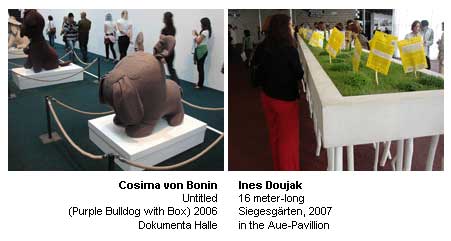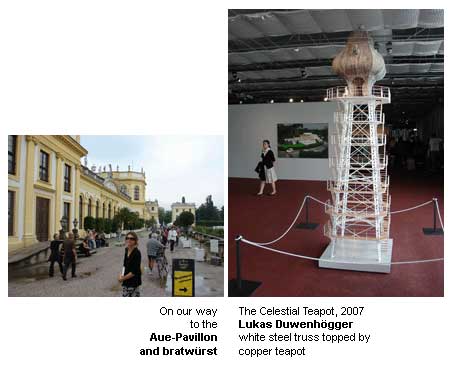Previous Post Next Post
Thursday, September 13th, 2007
Dokumenta, Kassel, Germany, 6.16-9.23.07
artist Susannah Auferoth revisits
Expecting to encounter a huge global audience speaking unidentifiable languages, my German husband Dirk and I drove from Münster to Kassel to attend Dokumenta 12. Instead we found a rather sedate, socks-with-sandals crowd which gave us loads of time to peruse the actual art and grounds.

In Museum Fridericianum, the first venue we visited, I was immediately drawn to Hu Xiaoyuan’s delicate and creepy hair-of-the-artist embroidery on white silk (wooden embroidery rings still in place) bearing images of lips, peacocks; flora. It occurred to me that a lot of art making, my own included, could pass for small slices of OCD fixations. Not far from that stands Zheng Guogu‘s rectangular waterfall of wax-dipped calligraphic texts culled from amateur (ie non-elite) calligraphers. Serene and stylized, the wax drips formed shapes reminiscent of ancient Chinese depictions of wave spray and mountain trees, and, possibly, Scooby-Doo graphics.
Moving on, we encountered Iole De Freitas’ large steel and plexiglass panels swooping through the formal space and appearing to penetrate the walls and hover along the facade. It occurred to me as I ducked over and around the barriers that I was following a persons line of sight which led both Dirk and I to consider that it worked as a segue for the next rooms artwork, which, it so happens, we have forgotten.
Die grosse Ausstellung hat keine Form, hence the works were scattered chronologically, geographically, and…..it worked! Once you stop yourself from trying immediately to answer who-what-why-where you enter into the Dokumenta 12 zone and accept willingly all things presented. If you fight it, fatigue will set in. Are those soggy puzzle pieces in front of Dokumenta Halle part of the show?

While in the midst of Iñigo Manglano-Ovalle’s Phantom Truck installation in the Dokumeta Halle, Dirk and I both shuddered and said ‘WMD’ to one another. We moved on and found the exhibition deeper than we ever imagined. I wanted to have sleepover in the Aue-Pavillion, even more so after I accidentally walked into Gerwald Rockenshaub’s artwork which was soft and large and warm. (thought bubble: Dokumenta as sleep-over space) Monika Baer’s large eerie vampire painting gave us pause. Dirk spent time trying to decipher her vaporous iconography while I wondered about the use of Prussian blue and the Brothers Grimm, who wrote many of their stories in Kassel.
One wonderful addition to the entire exhibition was Ai Weiwei’s 1001 Quing dynasty chairs placed in small conversational groupings throughout the venues. Almost too good to be true, you were allowed to sit on them. They had been used to form part of a Fairytale event (again, Brothers Grimm) where Chinese citizens were invited to a taste of non-China. I did not witness the event but sat in these beautifully-formed wooden chairs staring directly into the eyes of other weary, culture-soaked attendees. The intimacy was palpable and, therefore, nicely comical.
Romuald Hazoumé constructed a boat out of plastic cannisters for his Dream installation. The boat won’t float: it’s full of gaping holes from the cannister openings. The piece reminded Dirk and I of being on a almost deserted tropical island and discovering a white sand beach covered with hundreds of seaweed-covered plastic cannisters.
Containers and what they contain…what different societies carry on their backs. That’s very much the gist of the show right there.
Susannah Auferoth
The exhibition is very post-war German in it’s presentation; sincere, exploratory, and with a bit of precise humor. Dokumenta is set in six buildings in the city of Kassel, most within walking distance of each other, the exception being the Schloss Wilhelmshöhe set within the Bergpark. There is one other building taking part in Dokumenta this year in Roses, Spain which we didn’t see.

In Museum Fridericianum, the first venue we visited, I was immediately drawn to Hu Xiaoyuan’s delicate and creepy hair-of-the-artist embroidery on white silk (wooden embroidery rings still in place) bearing images of lips, peacocks; flora. It occurred to me that a lot of art making, my own included, could pass for small slices of OCD fixations. Not far from that stands Zheng Guogu‘s rectangular waterfall of wax-dipped calligraphic texts culled from amateur (ie non-elite) calligraphers. Serene and stylized, the wax drips formed shapes reminiscent of ancient Chinese depictions of wave spray and mountain trees, and, possibly, Scooby-Doo graphics.
Moving on, we encountered Iole De Freitas’ large steel and plexiglass panels swooping through the formal space and appearing to penetrate the walls and hover along the facade. It occurred to me as I ducked over and around the barriers that I was following a persons line of sight which led both Dirk and I to consider that it worked as a segue for the next rooms artwork, which, it so happens, we have forgotten.
Die grosse Ausstellung hat keine Form, hence the works were scattered chronologically, geographically, and…..it worked! Once you stop yourself from trying immediately to answer who-what-why-where you enter into the Dokumenta 12 zone and accept willingly all things presented. If you fight it, fatigue will set in. Are those soggy puzzle pieces in front of Dokumenta Halle part of the show?

While in the midst of Iñigo Manglano-Ovalle’s Phantom Truck installation in the Dokumeta Halle, Dirk and I both shuddered and said ‘WMD’ to one another. We moved on and found the exhibition deeper than we ever imagined. I wanted to have sleepover in the Aue-Pavillion, even more so after I accidentally walked into Gerwald Rockenshaub’s artwork which was soft and large and warm. (thought bubble: Dokumenta as sleep-over space) Monika Baer’s large eerie vampire painting gave us pause. Dirk spent time trying to decipher her vaporous iconography while I wondered about the use of Prussian blue and the Brothers Grimm, who wrote many of their stories in Kassel.
One wonderful addition to the entire exhibition was Ai Weiwei’s 1001 Quing dynasty chairs placed in small conversational groupings throughout the venues. Almost too good to be true, you were allowed to sit on them. They had been used to form part of a Fairytale event (again, Brothers Grimm) where Chinese citizens were invited to a taste of non-China. I did not witness the event but sat in these beautifully-formed wooden chairs staring directly into the eyes of other weary, culture-soaked attendees. The intimacy was palpable and, therefore, nicely comical.
Romuald Hazoumé constructed a boat out of plastic cannisters for his Dream installation. The boat won’t float: it’s full of gaping holes from the cannister openings. The piece reminded Dirk and I of being on a almost deserted tropical island and discovering a white sand beach covered with hundreds of seaweed-covered plastic cannisters.
Containers and what they contain…what different societies carry on their backs. That’s very much the gist of the show right there.
Susannah Auferoth